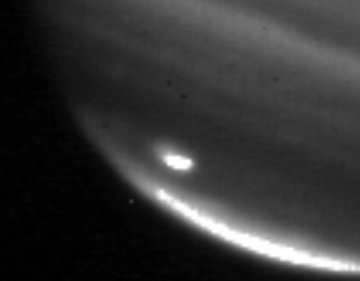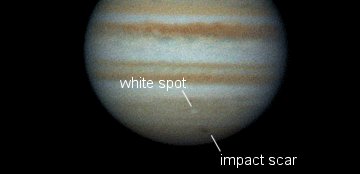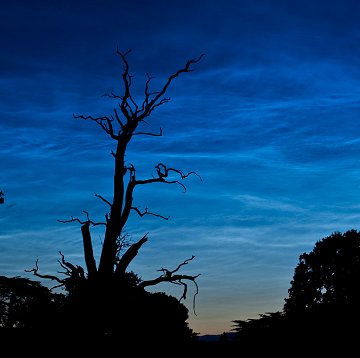| July 21, 2009 | ||||||
SOLAR ECLIPSE: The longest solar eclipse of the 21st century takes place this Wednesday, July 22nd. The path of totality crosses many major cities, setting the stage for possibly the best-observed eclipse in human history. Get the full story from Science@NASA. COSMIC COLLISION: Evidence is mounting that something hit Jupiter no more than a few days ago. The impact site was discovered by amateur astronomer Anthony Wesley on July 19th. Using a 14.5-inch telescope at his backyard observatory in Murrumbateman, Australia, he photographed a dark scar in Jupiter's clouds. NASA astronomers rushed to confirm the find, and with this photo from the Infrared Telescope Facility in Hawaii, they did: The bright spot is near-infrared sunlight reflected from particulate matter floating through the top of Jupiter's atmosphere. These particulates are likely debris from something that hit the planet and exploded. "This has all the hallmarks of the comet Shoemaker-Levy 9 impacts of 1994," says Leigh Fletcher of JPL who gathered the infrared data along with colleague Glenn Orton. If the impact hypothesis is indeed correct, the "scar" should become spread out by jet streams in the days ahead. Amateur astronomers can monitor events using mid-sized backyard telescopes: sky map. The spot is located near Jupiter's System II longitude 210°. For the predicted times when it will cross the planet's central meridian, add 2 hours and 6 minutes to Sky and Telescope's predicted transit times for Jupiter's Great Red Spot. UPDATE: On July 20th, Dennis Simmons of Brisbane Australia recorded a 75-minute movie of the impact site. Click on the image to launch a gif animation: "It is quite fascinating to observe the white spot (a Mars-sized storm) appearing to overtake the impact scar," notes Simmons. "To make the movie I used a 7-inch Takahashi Mewlon 180 telescope with a Vixen x2 Barlow and a DBK21AF04 ccd camera." more images: from Antonello Medugno of Italy; from Robert Lunsford of Chula Vista, California; from Jeremy Perez of Flagstaff, Arizona; from Theo Ramakers of Social Circle, Georgia; from Anthony Wesley of Murrumbateman, Australia; from Ian Sharp of Ham, West Sussex, England, UK; from David Kolb of Lawrence, Kansas; from David Storey of Isle of Man, Great Britain; from Frank Ryan Jr of Shannon, Ireland; from Russell Hawker of Eastleigh, Hampshire; from Lars Zielke of Tvis, Denmark; NOCTILUCENT CLOUDS: Noctilucent clouds are brightening again over Europe. "On July 20th we had a fantastic display--possibly the best of the year so far," reports John Houghton of Leicester UK. He snapped this photo using a Nikon D700: The display was vivid electric-blue and included some unusual forms. "They reminded me of a great whale swimming across the sky," remarks eyewitness Peter Vasey of Hexham UK. When a similar display materialized over Europe last week, the clouds quicky spread across the Atlantic, appearing in the USA as far south as Utah, Colorado, northern California and Nevada. Could it happen again tonight? Browse the photo gallery for observing tips: UPDATED: 2009 Noctilucent Photo Gallery | ||||||
Tuesday, 21 July 2009
What's up in Space
Subscribe to:
Post Comments (Atom)






No comments:
Post a Comment